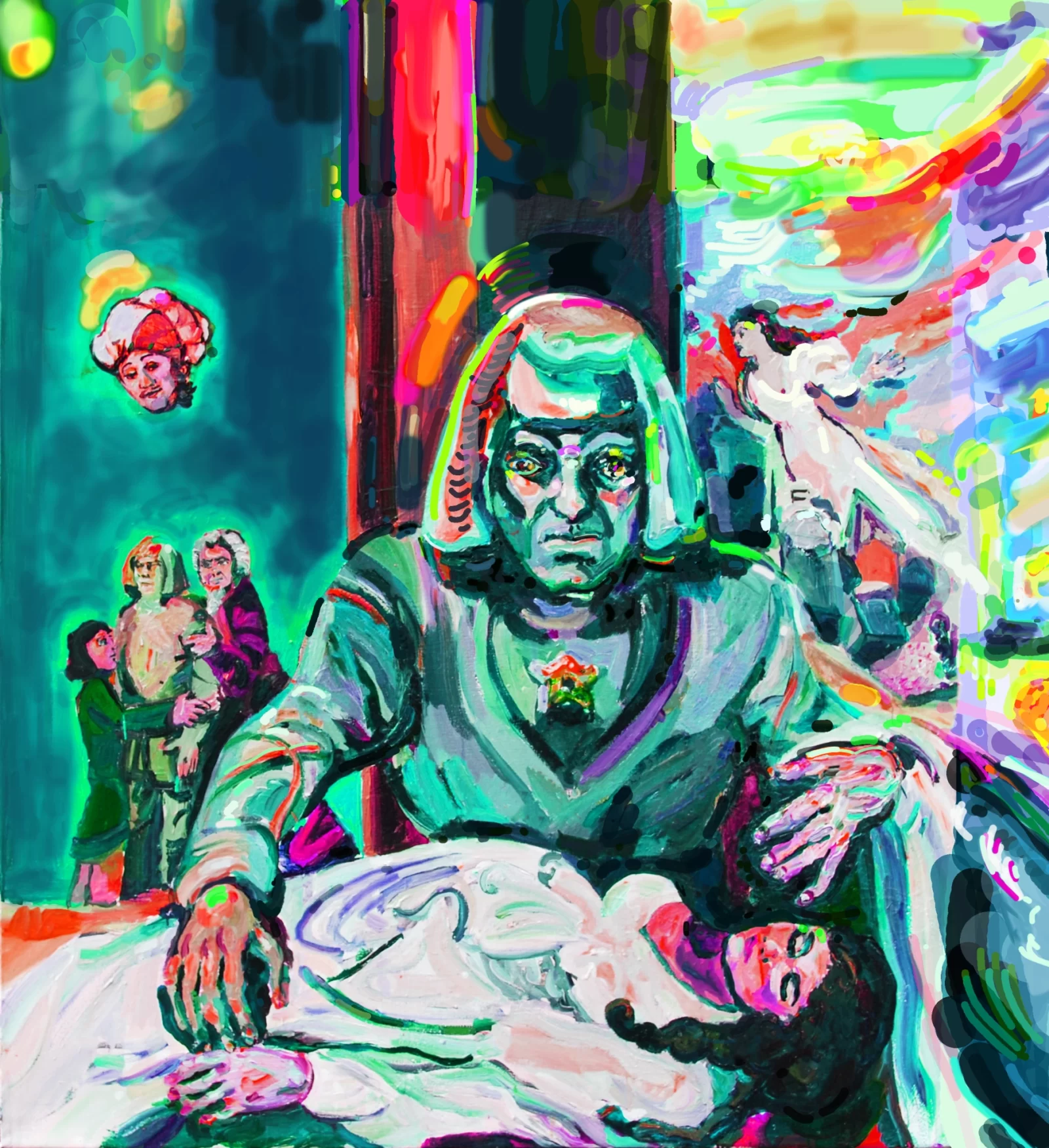Green Golem

Joel Silverstein is an internationally exhibited artist, often working with…
Green Golem is artwork by Joel Silverstein (acrylic and digital).
A note from the artist:
Envisioned as a protector of the Jewish people, and perhaps a potential menace when used incorrectly, the Golem has always occupied a special place in Western lore. Whether superhero, monster, or suffering servant, this creature has riveted both Jewish and non-Jewish audiences for hundreds of years. Although the story dates back to the 6th Century, CE, the narrative has gained special recognition in our own, post-Frankensteinian age. I have been obsessed with the character since childhood, in my own mind tying the identity of the Golem to the comic book hero, Superman. I created initial versions on the theme dating back to the 1980s. This current image, completed a few days ago, was created specifically for The Green Golem magazine. The iconography is derived from multiple sources; its visual prototype taken directly from the German Expressionist cinematic masterpiece, The Golem , How He Came into the World, 1920, by Paul Wegener, a silent horror film. Wegener, who acted, directed, and wrote the screenplay, influenced many generations of artists and film-makers , including James Whale’s and Jack Pierce’s ’s conception of Frankenstein for the 1931 movie. The visual motif of the Golem menacing the beautiful female protagonist mirrors mythic global tropes concerning monsters and beautiful maidens of all sorts, but also reflects the contemporaneous German audience’s deeply seated fears of Jewish/German interbreeding and miscegenation. In just a few years from the time of the film, the Nazi regime would enact strong anti-marriage laws between these groups.
The spectral floating head on the left side of the painting is from Rembrandt’s Jacob Blessing the Sons of Joseph (1656). Jacob is the progenitor and name-sake of Israel, hence the Jewish people. The floating head is actually that of Joseph standing above the bed of his father. Rembrandt, a Dutch Protestant painter of the 1600’s envisioned the Hebraic Joseph, the Egyptian Vizier and favorite of Pharaoh , as a turbaned, romantic, and ”Orientalized” figure, an image of Jews that persisted for several hundred years within European lore. At bottom left, the Golem is restrained by the Maharal, Rabbi Judah Lowe Ben Bezalel, (1526? – 1609) traditional creator of the Prague Golem, and his assistant. On the right side of the painting , a white, gown-clad grieving woman, her arms thrown out in seemingly sculptural relief. The figure is taken from Titian’s The Burial of Christ (1572): that of Mary Magdalene, evoking Christian concepts of death, resurrection and the coming of the Messiah. In this case, the scene implies the Golem’s role as sacredly appointed protector of the Jews. During the historical period depicted in the Wegener film, Jewish economic, scientific, and cultural achievements were critically undermined by discrimination and deadly pogroms which swept through Central and Eastern Europe in the late 1500s.
The role of the Golem as super, or trans-human protector, and its own lack of soul, perfectly describes the perilous position of Jews at the time, and how they were perceived by the European majority. Pre-modern Jewish communities in Europe were permitted only a perilous religious life, under constant physical threat by ecclesiastic, local, and monarchic authorities, but no political power, self-determination, or true governance. As such, the Golem is both a hostile projection of alien oppression and the wish fulfillment of the Jewish spirit, willfully transcending both time and place. The Golem is both Superman and Frankenstein, a supremely metaphorical figure, in sync with both the Jewish community, and the world for our current age: a mediation on the origins, responsibilities, and deployment of power, balancing the perceived demands of a divinely given religious law, violent action, and personal responsibility, all whistled in a Jewish key.
Joel Silverstein is an internationally exhibited artist, often working with Jewish themes. Since 2008, he is Founding and Executive Board Member of the Jewish Art Salon, and is currently its Director of Exhibitions, a post he holds with Richard McBee. Joel has curated or personally advised on 16 Salon exhibitions, including Genesis: The Beginning of Creativity at: Riverside Church, The Interchurch Center, and The JewishTheological Seminary, NY. Recent exhibitions of his own work include two one-person exhibitions at HUC Dr. Bernard Heller Museum, NY, group exhibitions at the Amstelkirk Gallery in Holland, Art Basil Miami, Jada Art Week Paris, and the Jerusalem Biennale, 2015, 2017. His work and curated exhibitions are cited in Ori Z. Soltes’ Tradition and Transformation; Three Millennium of Jewish Art & Architecture and Matthew Baigell’s Jewish Identity in American Art, a Golden Age Since the 1970s. He is also a grant winner for his achievements in Jewish Culture from The Memorial Foundation for Jewish Culture (2022-2023) and the author/artist of the newly released book, The Brighton Beach Bible, published by The Jewish Art Salon.
Find his website at https://www.joelsilversteinart.com/
What's Your Reaction?
Joel Silverstein is an internationally exhibited artist, often working with Jewish themes. Since 2008, he is Founding and Executive Board Member of the Jewish Art Salon, and is currently its Director of Exhibitions, a post he holds with Richard McBee. He is also a grant winner for his achievements in Jewish Culture from The Memorial Foundation for Jewish Culture (2022-2023) and the author/artist of the newly released book, The Brighton Beach Bible, published by The Jewish Art Salon.














To Lisa W and Michael H
I am grappling with the advise I should give
Regarding your right to continue to live
Given that you are clearly Nazi collaborators
Lisa you thought that I was a poor person with no power
Michael you thought the same
I was perplexed at how this would justify what you did to me in your tiny little pee brains
I was raised to do the opposite
Treat poor people with upmost respect
Because usually they are victims or due to no fault of their own they have witnessed something and their poverty is a way of rendering their view as irrelevant
This is how I was taught
But it has been made clear to me
How you were taught
At your dirty corrupt little Jewish day schools
And so my judges that help me decide if you should live or die
Have explained to me that you were the poor
In your little world of stupid fake Jews
That I should give you leniency
I have decided to recommend that you be permitted to live
To send a message about poor upbringing
But I will hear back
If you failed to live up to my new higher expectations
And although you may continuing breathing for now
Given your crimes
Do not consider this as a fixed state
Nonetheless
An early death has been prescribed
As your type of betrayal
Is beyond the pale !